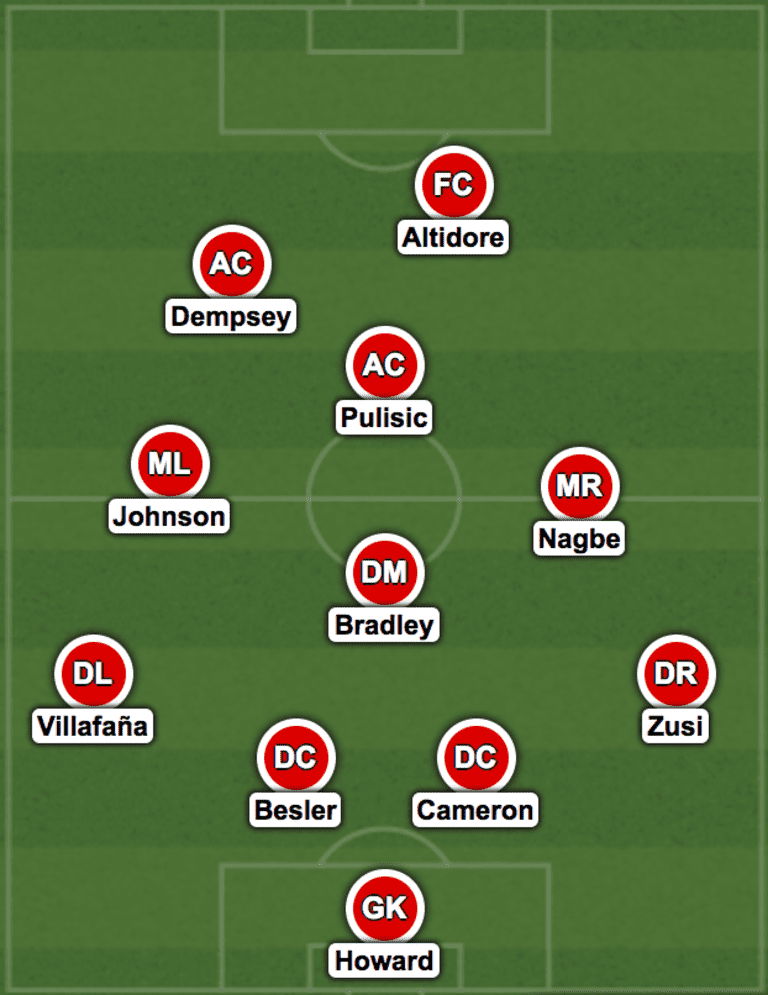ExtraTime Radio Podcast

LISTEN: You haven't heard Darlington Nagbe like this before. In a relaxed interview from the USMNT hotel, the Timbers man explains why the middle third is his favorite, why his family comes first and what representing his country means to him. Taylor Twellman joins for the complete US-Costa Rica preview. Subscribe now and "Like" our Facebook page so you never miss a show! Download this episode!
Every round of World Cup qualifiers isn't just a chance to collect points, even if it's primarily a chance to collect points. Success or failure will be determined by those numbers.
Still, there are always underlying questions facing each and every team trying to qualify for the World Cup, and how those questions are answered can often go a long way toward determining where a team falls along the success/failure spectrum. Winning teams, in other words, tend to figure stuff out about themselves on the journey.
That's what's facing Bruce Arena and the USMNT ahead of the next two installments of the Hexagonal. First up will be Costa Rica on Friday evening (6:30 pm ET; ESPN, Univision & UDN), followed by a trip to Honduras next Tuesday.
I've already made my lineup and points predictions HERE. Now let's look at the questions that Arena & Co. will get a chance to answer:
Is there a default US formation?
Arena has been ridiculously flexible over the past eight months. In the first US qualifier he used a 4-1-3-2, then followed it up with a flat 4-4-2, then moved to something of a 4-2-2-2, then a 5-4-1 in Mexico, and played primarily a 4-2-3-1 in the Gold Cup. Here's my guess at Friday:

You could call it a 4-1-3-2 or a 4-3-2-1. There's a better than decent chance that if both Clint Dempsey and Christian Pulisic start, they'll spend a ton of time operating along the same latitudinal axis just underneath the lone furrow plowed, presumably, by Jozy Altidore.
I am fine with this – happy with it, even. Arena has gotten his team to play well across multiple formations because he has a ton of talent at hand (more than at any previous point in the program's history), and because he's a meticulous, prepared coach who doesn't frequently ask his players to go outside their comfort zone based solely upon philosophical reasons. He asks them to do stuff they can do, and then puts them in a structure to do it.
And we've all seen Arena weaponize formational variation in the past, right? The 3-5-2 he sprung on Mexico in 2002's Round of 16 came out of the blue, as the US hadn't played in that set-up for more than 18 months. But they'd practiced it, and then they executed it when it really mattered.
All of this is good. I am a firm believer, however, that every team has one look in which they're the most solid, the most dangerous, the most comfortable.
That hasn't been found for the US just yet. This search is, perhaps, a function of Pulisic's ongoing positional evolution – he's played right wing, left wing and as a No. 10 for both Borussia Dortmund and the US, all before his 19th birthday. Thus far I'd argue he's best on the right wing, most individually dangerous on the left and most influential as a 10. Where, then, does that leave him for the US?
There doesn't have to be just one true answer. But there probably should be one answer that's more true than the others.
Speaking of Pulisic...
Can Pulisic and Dempsey play significant minutes together?
They certainly managed it against Honduras in March, that 6-0 US win that rescued the qualifying campaign. And they then combined on the only US goal a few days later in a 1-1 draw at Panama. They've had their moments.
They had, however, few moments together in June, and often seemed to get in each other's way during a 1-1 friendly draw against Venezuela followed by a 2-0 WCQ win over Trinidad & Tobago. Dempsey was subbed off around the hour mark in both games, then didn't play against Mexico in the subsequent qualifier.
My baseline assumption is this: They're both smart players, and smart players tend to figure things out. They'll be fine.
That said...
Will Dempsey continue to thrive in a reduced role?
It's been more than a decade since Dempsey was anything but a centerpiece for the US, yet over the last three months we've seen his role somewhat reduced as Father Time does his thing and as a cadre of new, younger attacking talent pushes through the ranks. Following what was, for him, a disappointing set of games in June, Deuce was primarily a super-sub in the Gold Cup.
He was game-changing in that role:
He'll continue to be game-changing as long as he buys in. My guess is he starts one of these games and goes less than the full 90, then comes off the bench for the other.
Though to be perfectly honest it wouldn't be shocking if he came off the bench for both. Dempsey's ability to get on the ball and do work in the half-spaces, as above, is the ideal way to A) change your own attack's shape, and B) unlock a packed-in defense. I'm sure he'd prefer to do it for 90, but thus far he's been devastating when asked only to do it for 30.
This is fine. It's the right role for him at this stage in his career.
Who's the No. 8? Will the US even use one?
Let's go back to that original question about formations. In the 4-1-3-2 or the 4-3-2-1, there's really only one deep-lying, strictly central midfielder: Michael Bradley. He's been deployed as a pure No. 6, a defensive midfielder, almost exclusively under Arena.
That's a very good thing, as the US have allowed just one open play goal in the 14 hours Bradley's been on the field this year. But it's also a risk – teams will scout the US and flood numbers centrally, dragging players inside from the flanks or (worse, from a US point of view) pulling Pulisic deeper from his presumed No. 10 role to drop deep and help out defensively.
Throughout the history of the game this has been countered by slotting in a second deep-lying midfielder, one with fewer defined defensive responsibilities: The No. 8. The 6/8 pairing necessitates a formational shift, and is the strength of the 4-2-3-1 system that largely dominated the first 15 years of this new century. It's also supposed to be one of the strengths of the old-fashioned 4-4-2, and is definitely the strength of the 5-4-1 that Costa Rica will play on Friday. Just adding more bodies to that part of the field often helps.
In the 4-1-3-2 or 4-3-2-1, teams compensate by having the wide guys on the "3" line tuck inside to help the defensive midfielder. Usually we think of wide midfielders as having primarily north-south responsibilities, but in the modern game they have to be focused as much or more on east-west spacing and defensive reactions.
It's a fairly unusual role these days, and of the two guys who I think will start – Fabian Johnson on the left, Darlington Nagbe on the right – Nagbe is the one who more naturally drifts inside, and is probably a more natural No. 8. There will be times, in the formation above, where he absolutely has to help Bradley out even though Arena really does like his wide midfielders to stay wider than you usually see in a 4-1-3-2.
If the US go to a 4-2-3-1 or a 5-4-1 at Honduras, there will be more room for a traditional No. 8. Nagbe could fit into that role, but so could Kellyn Acosta, Cristian Roldan and Alejandro Bedoya. Acosta's gotten the most run in qualifiers this year; Roldan is in the best club form; Bedoya was the best of the three at the Gold Cup.
The smart money says one of them starts on Tuesday.
How high will the fullbacks push?
CONCACAF is a counterattacking region. Costa Rica have elevated it to a high art, and it's really the only phase of the game in which Honduras have been dangerous.
The US, when playing with a back four, have been very good this year but have been so by taking risks primarily with the positioning of their fullbacks. Obviously it's paying off – in 2017 the Yanks have scored 27 goals and conceded just eight despite playing most of the year without huge chunks of their first-choice defense. Managing risk/reward scenarios has always been one of Arena's strengths.
Still, just look at how high Jorge Villafaña and DeAndre Yedlin played throughout the most recent home qualifier, that 2-0 win over T&T:
Yedlin can mostly get away with that because he can hit Mach 2 at a full sprint. His likely replacement on Friday, Graham Zusi, decidedly can not, and neither can Villafaña. Teams haven't been able to take advantage of this just yet, but sooner or later one of the fullbacks will get caught out and the US will concede.
When it happens – and again, eventually it will happen – I hope the US don't react by pulling back into a more conservative shell. This team has put together a dominant year by pushing numbers forward, giving options across the field in distribution, attacking from angles, and using possession as a weapon in both attack and defense.
It's a new identity for the US. It's gotten them points, and answered some questions along the way. And now, with four games left to go in the Hexagonal, they're just a few steps from Russia.












